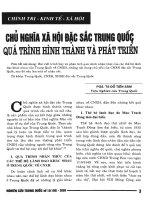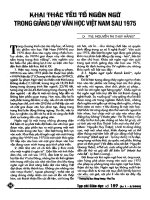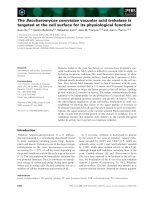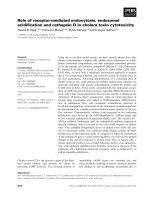Tài liệu Báo cáo khoa học: "Unlimited Vocabulary Grapheme to P h o n e m e Conversion for Korean TTS" pdf
Bạn đang xem bản rút gọn của tài liệu. Xem và tải ngay bản đầy đủ của tài liệu tại đây (476.91 KB, 5 trang )
Unlimited Vocabulary Grapheme to Phoneme Conversion for
Korean TTS
Byeongchang Kim and WonI1 Lee and Geunbae Lee
and Jong-Hyeok
Lee
Department of Computer Science & Engineering
Pohang University of Science & Technology
Pohang, Korea
{bckim, bdragon, gblee, jhlee)@postech.ac.kr
Abstract
This paper describes a grapheme-to-phoneme
conversion method using phoneme connectivity
and CCV conversion rules. The method
consists of mainly four modules including
morpheme normalization, phrase-break detec-
tion, morpheme to phoneme conversion and
phoneme connectivity check.
The morpheme normalization is to replace
non-Korean symbols into standard Korean
graphemes. The phrase-break detector assigns
phrase breaks using part-of-speech (POS)
information. In the morpheme-to-phoneme
conversion module, each morpheme in the
phrase is converted into phonetic patterns
by looking up the morpheme phonetic pat-
tern dictionary which contains candidate
phonological changes in boundaries of the
morphemes. Graphemes within a morpheme
are
grouped into CCV patterns and converted
into phonemes by the CCV conversion rules.
The phoneme connectivity table supports
grammaticality checking of the adjacent two
phonetic morphemes.
In the experiments with a corpus of 4,973
sentences, we achieved 99.9% of the grapheme-
to-phoneme conversion performance and 97.5%
of the sentence conversion performance. The
full Korean TTS system is now being imple-
mented using this conversion method.
1 Introduction
During the past few years, remarkable improve-
ments have been made for high-quality text-
to-speech systems (van Santen et al., 1997).
One of the enduring problems in developing
high-quality text-to-speech system is accurate
grapheme-to-phoneme conversion (Divay and
Vitale, 1997). It can be described as a function
mapping the spelling of words to their phonetic
symbols. Nevertheless, the function in some al-
phabetic languages needs some linguistic knowl-
edge, especially morphological and phonologi-
cal, but often also semantic knowledge.
In this paper, we present a new grapheme-to-
phoneme conversion method for unlimited vo-
cabulary Korean TTS. The conversion method
is divided into mainly four modules. Each mod-
ule has its own linguistic knowledge. Phrase-
break detection module assigns phrase breaks
onto part-of-speech sequences using morpho-
logical knowledge. Word-boundaries before
and after phrase breaks should not be co-
articulated. So, accurate phrase-break assign-
ments are essential in high quality TTS sys-
tems. In the morpheme-to-phoneme conver-
sion module, boundary graphemes of each mor-
pheme in the phrase are converted to phonemes
by applying phonetic patterns which contain
possible phonological changes in the boundaries
of morphemes. The patterns are designed us-
ing morphological and phonotactic knowledge.
Graphemes within a morpheme are converted
into phonemes by CCV (consonant consonant
vowel) conversion rules which are automatically
extracted from a corpus. After all the conver-
sions, phoneme connectivity table supports the
grammaticality of the adjacency of two phonetic
morphemes. This grammaticality comes from
Korean phonology rules.
This paper is organized as follows. Section 2
briefly explains the characteristics of spoken Ko-
rean for general readers. Section 3 and 4 in-
troduces our grapheme-to-phoneme conversion
method based on morphological and phonolog-
ical knowledge of Korean. Section 5 shows
experiment results to demonstrate the perfor-
mance and Section 6 draws some conclusions.
675
2 Features of Spoken Korean
This section briefly explains the linguistic char-
acteristics of spoken Korean before describing
the architecture.
A Korean word (called eojeol) consists of more
than one morpheme with clear-cut morpheme
boundaries (Korean is an agglutinative lan-
guage). Korean is a postpositional language
with many kinds of noun-endings, verb-endings,
and prefinal verb-endings. These functional
morphemes determine the noun's case roles,
verb's aspect/tenses, modals, and modification
relations between words. The unit of pause in
speech (phrase break) is usually different from
that in written text. No phonological change
occur between these phrase breaks. Phonologi-
cal changes can occur in a morpheme, between
morphemes in a word, and even between words
in a phrase break as described in the 30 general
phonological rules for Korean(Korean Ministry
of Education, 1995). These changes include con-
sonant and vowel assimilation, dissimilation, in-
sertion, deletion, and contraction. For exam-
ple, noun "kag-ryo" pronounced as "kangnyo"
(meaning "cabinet") is an example of phono-
logical change within a morpheme. Noun
plus noun-ending "such+gwa", in which "such"
means "charcoal" and "gwa" means "and" in
English, is sounded as "sudggwa", which is
an example of the inter-morpheme phonologi-
cal change. "Ta-seos gae", which means "five
items", is sounded as "taseot ggae", in which
phonological changes occur between words. In
addition, phonological changes can occur condi-
tionally on the morphotactic environments but
also on phonotactic environments.
3 Architecture of the
Grapheme-to-Phoneme Converter
Part-of-speech (POS) tagging is a basic step
to the grapheme-to-phoneme conversion since
phonological changes depend on morphotactic
and phonotactic environments. The POS tag-
ging system have to handle out-of-vocabulary
(OOV) words for accurate grapheme-to-
phoneme conversion of unlimited vocabulary
(Bechet and E1-Beze, 1997). Figure 1 shows
the architecture of our grapheme-to-phoneme
converter integrated with the hybrid POS
tagging system (Lee et al., 1997). The hybrid
POS tagging system employs generalized OOV
word handling mechanisms in the morpho-
logical analysis, and cascades statistical and
rule-based approaches in the two-phase training
architecture for POS disambiguation.
table J I connectivity checker
"reefing
|
Figure 1: Architecture of the grapheme-to-
phoneme converter in TTS applications
Each morpheme tagged by the POS tagger
is normalized by replacing non-Korean symbols
by Korean graphemes to expand numbers, ab-
breviations, and acronyms. The phrase-break
detector segments the POS sequences into sev-
eral phrases according to phrase-break detec-
tion rules. In the phoneme converter, each mor-
pheme in the phrase is converted into phoneme
sequences by consulting the morpheme pho-
netic dictionary. The OOV morphemes which
are not registered in the morpheme phonetic
dictionary should be processed in two differ-
ent ways. The graphemes in the morpheme
boundary are converted into phonemes by con-
sulting the morpheme phonetic pattern dictio-
nary. The graphemes within morphemes are
converted into phonemes according to CCV con-
version rules. To model phoneme's connectabli-
ties between morpheme boundaries, the sepa-
rate phoneme connectivity table encodes the
phonological changes between the morpheme
with their POS tags. Outputs of the grapheme-
to-phoneme converter, that is, phoneme se-
676
quences of the input sentence, can be directly
fed to the lower level signal processing module
of TTS systems. Next section will give detail de-
scriptions of each component of the grapheme-
to-phoneme converter. The hybrid POS tagging
system will not be explained in this paper, and
interested readers can see the reference (Lee et
al., 1997).
4 Component Descriptions of the
Converter
4.1 Morpheme Normalization
The normalization replaces non-Korean sym-
bols by corresponding Korean graphemes. Non-
Korean symbols include numbers (e.g. 54, -
12, 5,400, 4.2), dates (e.g.
20/1/97,
20-Jan-
97), times (e.g. 12:46), scores (e.g. 74:64),
mathematical expressions (e.g. 4+5, 1/3), tele-
phone numbers, abbreviations (e.g. km, ha) and
acronyms (e.g. UNESCO, OECD). Especially,
acronyms have two types: spelled acronyms
such as OECD and pronounced ones like a word
such as UNESCO.
The numbers are converted into the correspond-
ing Korean graphemes using deterministic fi-
nite automata. The dates, times, scores, ex-
pressions and telephone numbers are converted
into equivalent graphemes using their formats
and values. The abbreviations and acronyms
are enrolled in the morpheme phonetic dictio-
nary, and converted into the phonemes using
the morpheme-to-phoneme conversion module.
4.2 Phrase-Break Detection
Phrase-break boundaries are important to
the subsequent processing such as morpheme-
to-phoneme conversion and prosodic feature
generation. Graphemes in phrase-break
boundaries are not phonologically changed
and sounded as their original corresponding
phonemes in Korean.
A number of different algorithms have been
suggested and implemented for phrase break
detection (Black and Taylor, 1997). The
simplest algorithm uses deterministic rules and
more complicated algorithms can use syntactic
knowledge and even semantic knowledge. We
designed simple rules using break and POS
tagged corpus. We found that, in Korean, the
average length of phrases is 5.6 words and over
90% of breaks are after 6 different POS tags:
conjunctive ending, auxiliary particle, case
particle, other particle, adverb and adnominal
ending. The phrase-break detector assigns
breaks after these 6 POS tags considering the
length of phrases.
4.3 Morpheme-to-Phoneme Conversion
The morphemes registered in the morpheme
phonetic dictionary can be directly converted
into phonemes by consulting the dictionary en-
tries. However, separate method to process the
OOV morphemes which are not registered in the
dictionary is necessary. We developed a new
method as shown Figure 2.
Apply
direct morpheme-to-phoneme conversion
and phonological connectivity assignment
Morpheme
t~muee~
dictionary
Convert graphemes in morpheme boundaries
and assign phonological connectivity
Moq~eme
phoneae
dictionary
Ill Ill
Convert graphemes
within morphemes
CCV conversion rule 1
,i
Figure 2: Morpheme-to-phoneme conversion for
unlimited vocabularies
The morpheme phonetic dictionary contains
POS tag, morpheme, phoneme connectivity
(left and right) and phoneme sequence for each
entry. We try to register minimum number
of morpheme in the dictionary. So it contains
only the morphemes which are difficult to pro-
cess using the next OOV morpheme conversion
modules. Table 1 shows example entries for
the common noun "pang-gabs", meaning "price
of a room" in hotel reservation dialogs. The
common noun "pang-gabs" can be pronounced
as "pang-ggam", "pang-ggab" or "pang-ggabss"
according to first phoneme of the adjacent mor-
phemes.
To handle the OOV morphemes, morpheme
phonetic
pattern
dictionary is developed to con-
tain all the general patterns of Korean POS
tags, morphemes, phoneme connectivity and
phoneme sequences. Boundary phonemes of
the OOV morphemes can be converted to their
candidate phonemes, and the phonological con-
nectivity for them can be acquired by consult-
ing this morpheme phonetic pattern dictionary.
677
Table 1: Example entries of the morpheme phonetic dictionary
POS tag morpheme phoneme sequence left connectivity right connectivity
common noun pang-gabs pang-ggam 'p' no change 'bs' changed to 'm'
common noun pang-gabs pang-ggab 'p' no change 'bs' changed to 'b'
common noun pang-gabs pang-ggabss 'p' no change 'bs' changed to 'bss'
Table 2: Example entries of morpheme phonetic pattern dictionary
POS tag morpheme phoneme sequence left connectivity right connectivity
t,d tt,n
irregular verb
irregular verb
irregular verb
irregular verb
t,Z
Y,d
Y,Z
tt,Z
Y,n
Y,Z
't' changed to 'tt'
't' changed to 'tt'
no change
no change
'd' changed to 'n'
no change
'd' changed to 'n'
no change
Example entries corresponding to the irregular
verb "teud", meaning "hear", are shown in Ta-
ble 2. Meta characters, 'Z', 'Y', 'V', '*' desig-
nate single consonant, consonant except silence
phoneme, vowel, any character sequence with
variable length in the order. The table shows
that the first grapheme 't' can be phonologically
changed to 'tt' according to the last phoneme
of the preceding morpheme (left connectivity),
and the last grapheme 'd' can be phonologically
changed to 'n' according to the first phoneme
of the following morpheme(right connectivity).
The morpheme phonetic pattern dictionary con-
tains similar 1,992 entries to model the general
phonological rules for Korean.
The graphemes within a morpheme for OOV
morphemes are converted into phonemes using
the CCV conversion rules. The CCV conversion
rules are the mapping rules between grapheme
to phoneme in character tri-gram forms which
are in the order of consonant(C) consonant(C)
vowel(V) spanning two consecutive syllables.
The CCV rules are designed and automatically
learned from a corpus reflecting the following
Korean phonological facts.
• Korean is a syllable-base language, i.e.,
Korean syllable is the basic unit of the
graphemes and consists of first consonant,
vowel and final consonant (CVC).
• The number of possible consonants for
each syllable can be varied in grapheme-
to-phoneme conversion.
• The number of vowels for each syllable is
not changed.
• Phonological changes of the first consonant
are only affected by the final consonant
of the preceding syllable and the following
vowel of the same syllable.
• Phonological changes of the final consonant
are only affected by the first consonant of
the following syllable.
• Phonological changes of the vowel are not
affected by the following consonant.
The boundary graphemes of the OOV mor-
phemes are phonologically changed according
to the POS tag and the boundary graphemes
of the preceding and following morphemes. On
the other hand, the inner grapheme conversion
is not affected by the POS tag, but only by
the adjacent graphemes within the same mor-
pheme. The CCV conversion rules can model
the fact easily, but the conventional CC conver-
sion rules (Park and Kwon, 1995) cannot model
the influence of the vowels.
4.4 Phoneme Connectivity Check
To verify the boundary phonemes' con-
nectablity to one another, the separate phoneme
connectivity table encodes the phonologically
connectable pair of each morpheme which has
phonologically changed boundary graphemes.
This phoneme connectivity table indicates the
grammatical sound combinations in Korean
678
phonology using the defined left and right con-
nectivity information.
The morpheme-to-phoneme conversion can gen-
erate a lot of phoneme sequence candidates for
single morpheme. We put the whole phoneme
sequence candidates in a phoneme graph where
a correct phoneme sequence path can be se-
lected for input sentence. The phoneme connec-
tivity check performs this selection and prunes
the ungrammatical phoneme sequences in the
graph.
5 Implementation and Experiment
Results
We implemented simple phrase-break detection
rules from break and POS tagged corpus col-
lected from recording and transcribing broad-
casting news. The rules reflect the fact that av-
erage length of phrases in Korean is 5.6 words
and over 90% of breaks are after 6 specific POS
tags, described in the texts.
We constructed a 1,992 entry morpheme pho-
netic pattern dictionary for OOV morpheme
processing using standard Korean phonological
rules. The morpheme phonetic dictionary was
constructed for only the morphemes that are
difficult to handle with these standard rules.
The two dictionaries are indexed using POS
tag and morpheme pattern for fast access. To
model the boundary phonemes' connectablity
to one another, the phoneme connectivity table
encodes 626 pair of phonologically connectable
morphemes.
The 2030 entry rule set for CCV conversion was
automatically learned from phonetically tran-
scribed 9,773 sentences. The independent pho-
netically transcribed 4,973 sentences are used
to test the performance of the grapheme-to-
phoneme conversion. Of the 4,973 sentences,
only 2.5% are incorrectly processed (120 sen-
tences out of 4,973), and only 0.1% of the
graphemes in the sentences are actually incor-
rectly converted.
6
Conclusions
This paper presents a new grapheme-to-
phoneme conversion method using phoneme
connectivity and CCV conversion rules for un-
limited vocabulary Korean TTS. For the effi-
cient conversion, new ideas of morpheme pho-
netic and morpheme phonetic pattern dictio-
nary are invented and the system demon-
strates remarkable conversion performance for
the unlimited vocabulary texts. Our main con-
tributions include presenting the morpholog-
ically and phonologically conditioned conver-
sion model which is essential for morpholog-
ically and phonologically complex agglutina-
tive languages. The other contribution is the
grapheme-to-phoneme conversion model com-
bined with the declarative phonological rule
which is well suited to the given task. We
also designed new CCV unit of grapheme-to-
phoneme conversion for unlimited vocabulary
task. The experiments show that grapheme-
to-phoneme conversion performance is 97.5%
in sentence conversion, and 99.9% in each
grapheme conversion. We are now working on
incorporating this grapheme-to-phoneme con-
version into the developing TTS systems.
References
F. Bechet and M. E1-Beze. 1997. Auto-
matic assignment of part-of-speech to out-of-
vocabulary words for text-to-speech process-
ing. In
Proceedings of the EUROSPEECH
'97, pages 983-986.
Alan W. Black and Paul Taylor. 1997. As-
signing phrase breaks from part-of-speech
sequences. In
Proceedings of the EU-
ROSPEECH '97,
pages 995-998.
Michel Divay and Anthony J. Vitale. 1997. Al-
gorithms for grapheme-phoneme translation
for English and French: Applications.
Com-
putational Linguistics,
23(4).
Korean Ministry of Education. 1995.
Korean
Rule Collections.
Taehan Publishers. (in Ko-
rean).
Geunbae Lee, Jeongwon Cha, and Jong-Hyeok
Lee. 1997. Hybrid POS tagging with general-
ized unknown-word handling. In
Proceedings
of the IRAL '97,
pages 43-50.
S.H. Park and H.C. Kwon. 1995. Implementa-
tion to phonological alteration module for a
Korean text-to-speech. In
Proceedigns of the
~th conference on Korean and Korean infor-
mation processing.
(in Korean).
Jan P.H. van Santen, Richard W. Sproat,
Joseph P. Olive, and Julia Hirschberg.
1997.
Progress in Speech Synthesis.
Springer-
Verlag.
679









